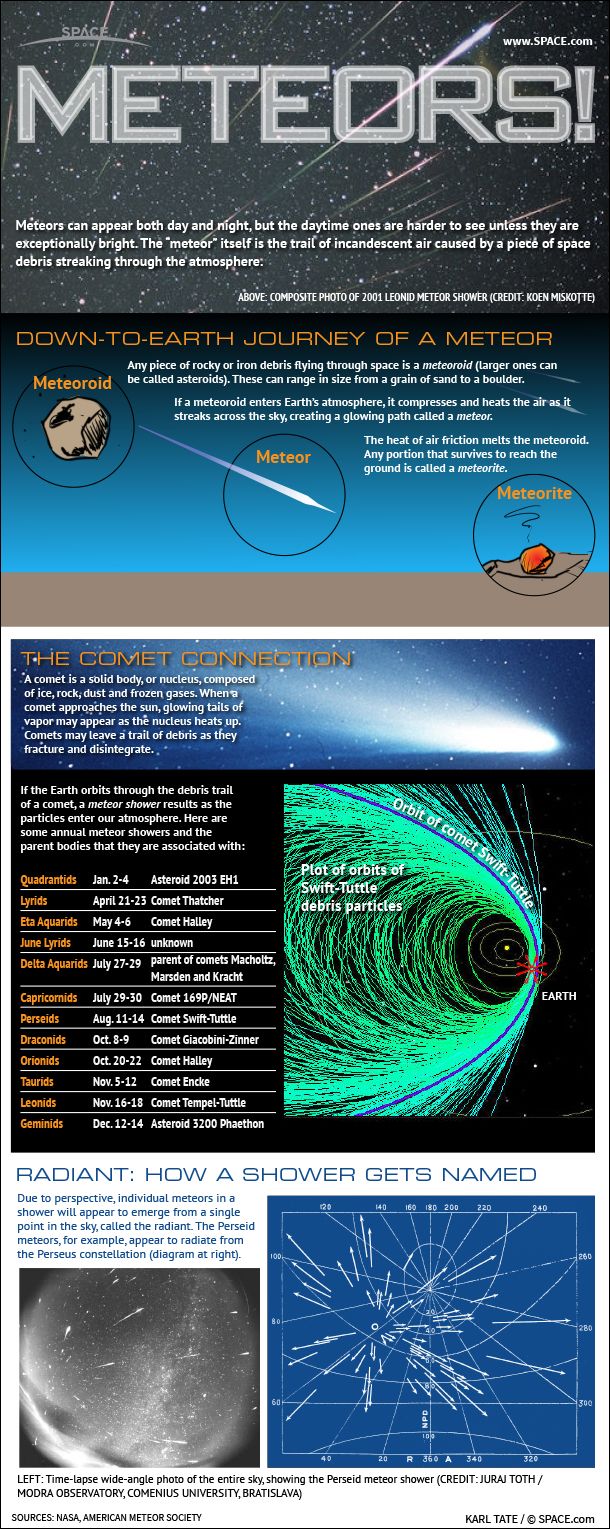How Meteor Showers Work (Infographic)

Meteors can appear both day and night, but the daytime ones are harder to see unless they are exceptionally bright. The “meteor” itself is the trail of incandescent air caused by a piece of space debris streaking through the atmosphere.
Any piece of rocky or iron debris flying through space is a meteoroid (larger ones can be called asteroids). These can range in size from a grain of sand to a boulder.
If a meteoroid enters Earth’s atmosphere, it compresses and heats the air as it streaks across the sky, creating a glowing path called a meteor.
The heat of air friction melts the meteoroid. Any portion that survives to reach the ground is called a meteorite.
Meteor showers are often connected to comets. A comet is a solid body, or nucleus, composed of ice, rock, dust and frozen gases.
When a comet approaches the sun, glowing tails of vapor may appear as the nucleus heats up. Comets may leave a trail of debris as they fracture and disintegrate. If the Earth orbits through the debris trail of a comet, a meteor shower results as the particles enter our atmosphere. [Amazing Perseid Meteor Shower Photos]
Here are some annual meteor showers and the parent bodies that they are associated with:
Breaking space news, the latest updates on rocket launches, skywatching events and more!
Quadrantids (Jan. 2-4), Asteroid 2003 EH1
Lyrids (April 21-23), Comet Thatcher
Eta Aquarids (May 4-6), Comet Halley
June Lyrids (June 15-16), unknown
Delta Aquarids (July 27-29), parent of comets Macholtz, Marsden and Kracht
Capricornids (July 29-30), Comet 169P/NEAT
Perseids (Aug. 11-14), Comet Swift-Tuttle
Draconids (Oct. 8-9), Comet Giacobini-Zinner
Orionids (Oct. 20-22), Comet Halley
Taurids (Nov. 5-12), Comet Encke
Leonids (Nov. 16-18), Comet Tempel-Tuttle
Geminids (Dec. 12-14), Asteroid 3200 Phaethon
Due to perspective, individual meteors in a shower will appear to emerge from a single point in the sky, called the radiant. The Perseid meteors, for example, appear to radiate from the Perseus constellation (diagram at right).
Follow SPACE.com on Twitter @Spacedotcom. We're also on Facebook & Google+.

Karl's association with Space.com goes back to 2000, when he was hired to produce interactive Flash graphics. From 2010 to 2016, Karl worked as an infographics specialist across all editorial properties of Purch (formerly known as TechMediaNetwork). Before joining Space.com, Karl spent 11 years at the New York headquarters of The Associated Press, creating news graphics for use around the world in newspapers and on the web. He has a degree in graphic design from Louisiana State University and now works as a freelance graphic designer in New York City.
